Discover how companies are responsibly integrating AI in production. This invite-only event in SF will explore the intersection of technology and business. Find out how you can attend here.
Atlassian has a new AI tool described as “a large knowledge model for your company.” Atlassian Rovo is the equivalent of an enterprise search engine, sourcing data from Atlassian’s family of apps and other third-party apps employees use daily to help them discover knowledge, learn from it and take action.
Gartner estimates nearly half of all digital workers struggle to find information or data needed to do their jobs effectively. They’re sifting for content stored in their email inbox, the cloud, Slack, Jira, Confluence, Trello, and countless other places. It can be daunting to remember where everything is. Rovo could be an optimal solution to help companies move work forward.
“Enterprises today work across dozens of tools. And finding information and staying on top of your knowledge within an organization is incredibly hard,” Sherif Mansour, Atlassian’s distinguished product manager and head of Atlassian Intelligence, tells VentureBeat. “Not only do they have large quantities of SaaS apps they use, but many enterprises have many internal apps or knowledge bases, custom-built apps or knowledge bases that are also super important for employees, call centers, staff or developers accessing internal API documentation. This stuff isn’t externally available on the web, so how do organizations harness all of that data and give all employees a productivity boost?”
What does Atlassian Rovo do?
Atlassian Rovo has three parts, all powered by Atlassian Intelligence, the AI assistant the company launched last year. Though each part could operate separately, when combined, they establish a collaboration loop that has the potential to improve discovering and taking action on information once spread across disparate internal tools.
Find
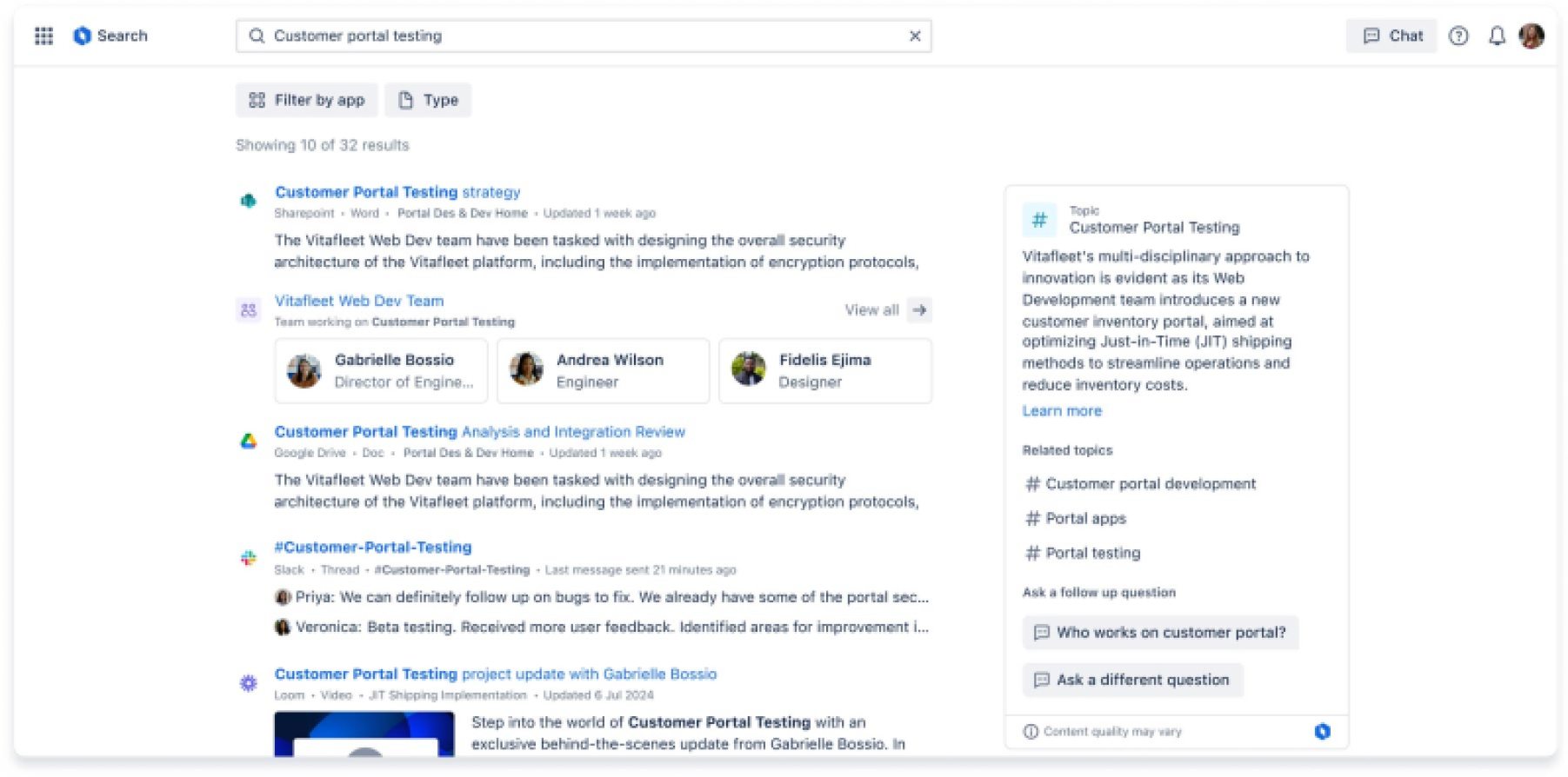
Find is a set of enterprise search capabilities within the Atlassian cloud. “The first thing Rovo Search does is index all your content from your third-party tools, as well as your internal tools inside your organization and put them all in one place,” Mansour says.
Individual workers do not choose which apps they want indexed—that decision is made by the Atlassian administrator. Some apps Rovo can pull information from include Google Drive, Microsoft Sharepoint, Microsoft Teams, GitHub, Slack, and Figma. Once app permission is granted, it’s enabled throughout the organization. However, Atlassian will respect every user’s permissions, so workers will see only those internally publicly available files and everything else they’ve been granted access to across all integrated apps. This is why search results will not be the same between workers.
Query results consist of document links, images and videos. When asked how Atlassian surfaces non-text files related to searches, Mansour shares that for videos, Atlassian relies on the transcripts to understand what was in the video. It’s supposedly similar for images, but there are plans to extract semantic meaning sometime after Rovo is generally available. “That’s something that we know is very doable,” he says.
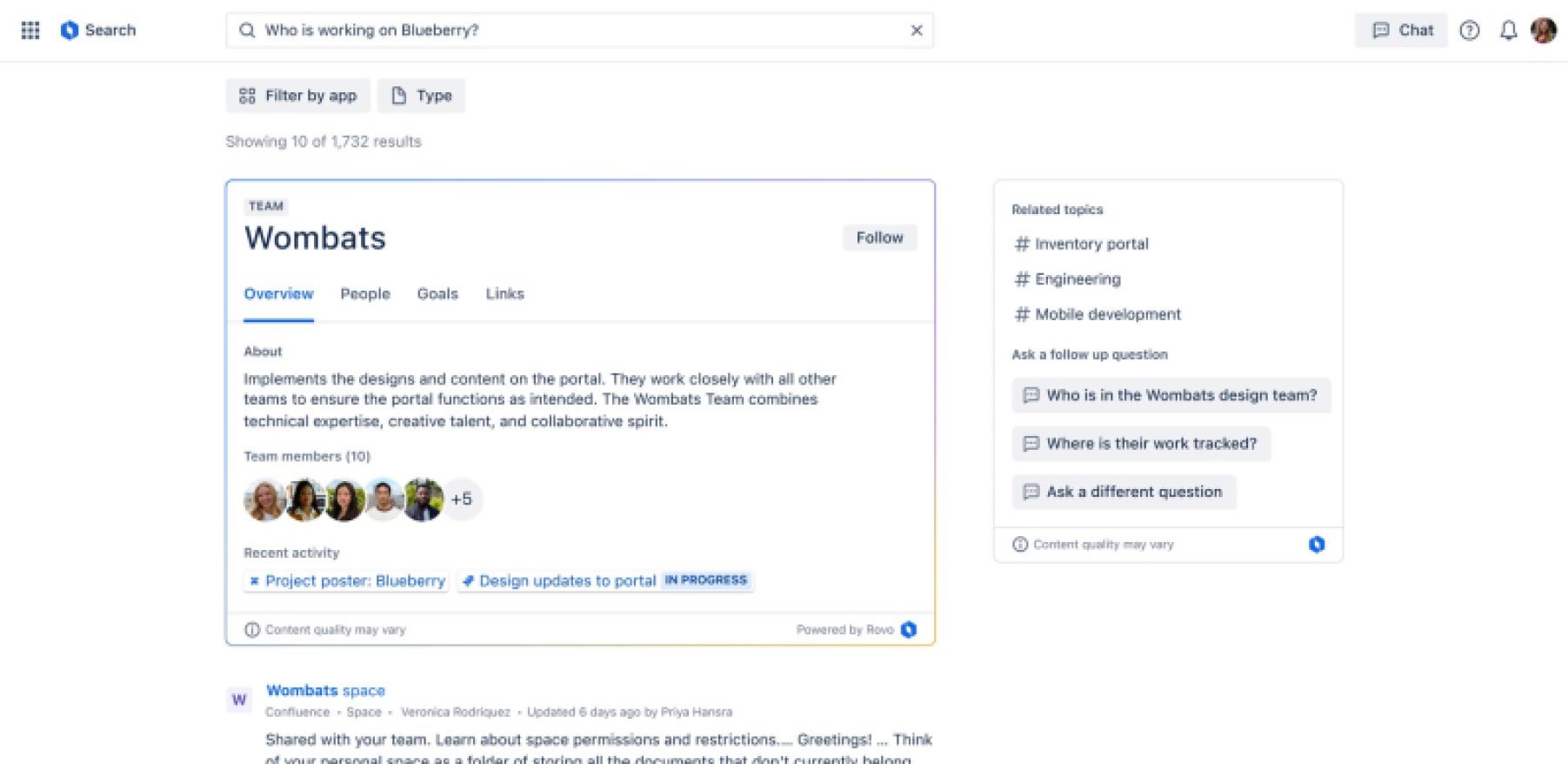
Knowledge cards, like those shown on Google search results, appear at the top of search results. If Rovo knows an answer, it’ll display a card, providing insights about projects, goals, teammates and more.
Following that are supporting resources and full search results, organized by multiple signals—no SEO gaming here. Rovo uses social signals and Atlassian’s teamwork graph to rank results, accounting for factors like whether you’ve seen or edited a page about the topic, whether you’ve worked with anyone on something about it, and whether there are projects with the topic in their name.
“Early signal suggests that a lot of people are getting the answers to their questions without having to sift through the 20 documents to work that out,” he asserts. “And I think that’s just an industry pattern you’ll see over time. As general AI gets better, people’s knowledge gets better in their organization.”
Learn
Learn is where education happens, offering workers a deeper understanding of their company’s data. AI can generate detailed write-ups about projects, meeting summaries, and more. Put another way, it’s “effectively a tailored company glossary for your organization that updates in real time.”
You could ask Rovo to provide the status of a marketing campaign, for example, and Atlassian says the AI will generate a detailed document, pulling information from relevant documents along with citations. It can also be used to answer questions about team members and processes.
“It is helping that problem of whether you’ve joined a squad in an organization, you’re just switching teams, or you’re joining an organization [and are] sent to some onboarding thing that goes for three weeks that you don’t even know what your day job is, this will deliver to you in context as you go,” Mansour explains.
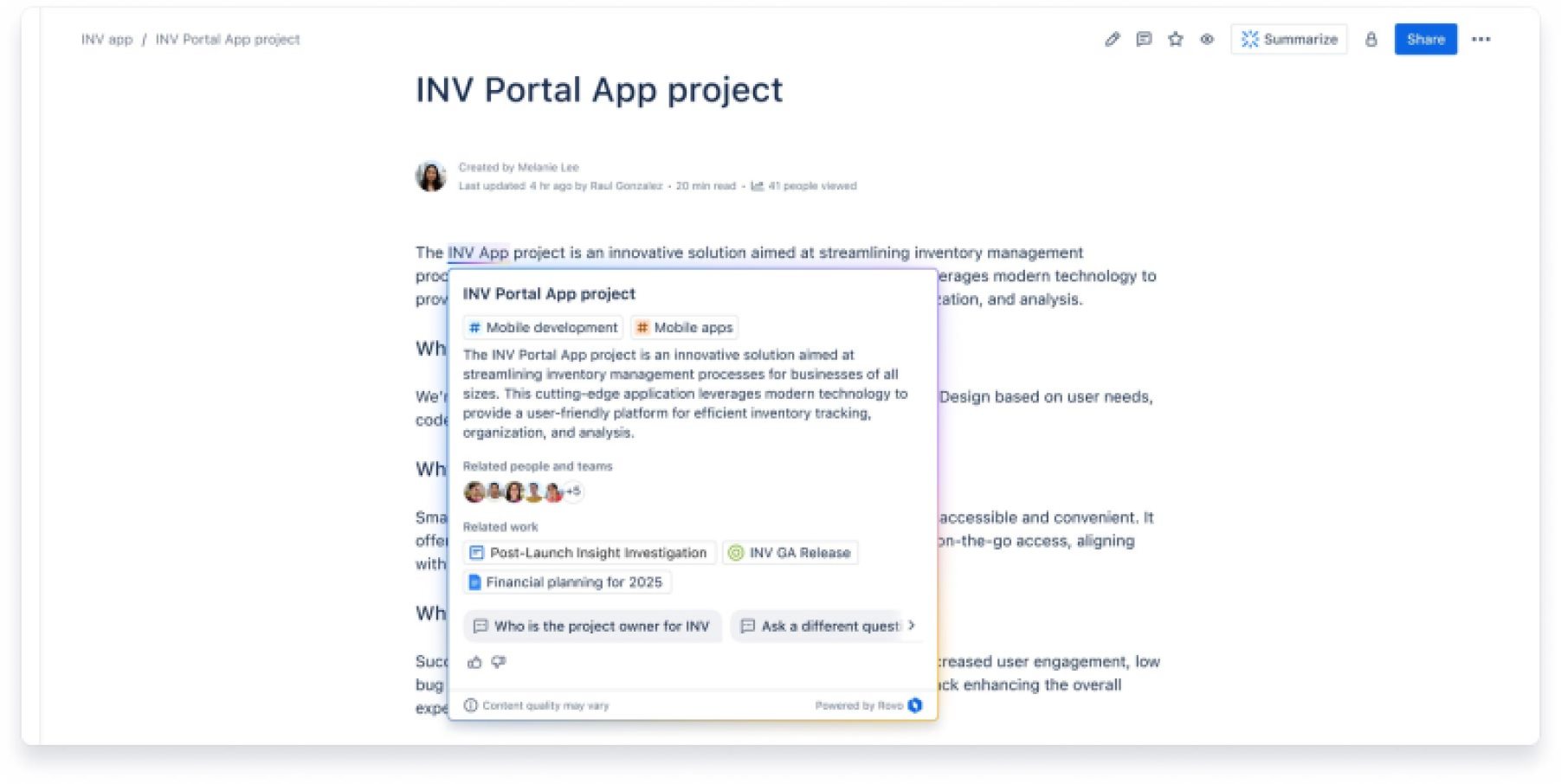
And if you happen to encounter acronyms or jargon you don’t understand, Rovo automatically inserts a feature that, when you mouse over a phrase marked with a rainbow-colored underline, will display a pop-up window showing a definition and relevant links to other content Rovo has indexed. “It’s bringing [company] knowledge not just in another separate search screen, which you can do. It’s actually bringing it to where you work and contextually showing you that knowledge as you work.”
A key tool within Learn is Rovo Chat, a chatbot that workers can use to answer questions, receive feedback or resolve issues. Like everything else with Rovo, Chat is based on the company’s data, so hallucinations should be minimized. “It’s not searching the internet,” Mansour states. “It can search the internet, but really the value here is extracting that stuff we put in Find and bringing the knowledge here.”
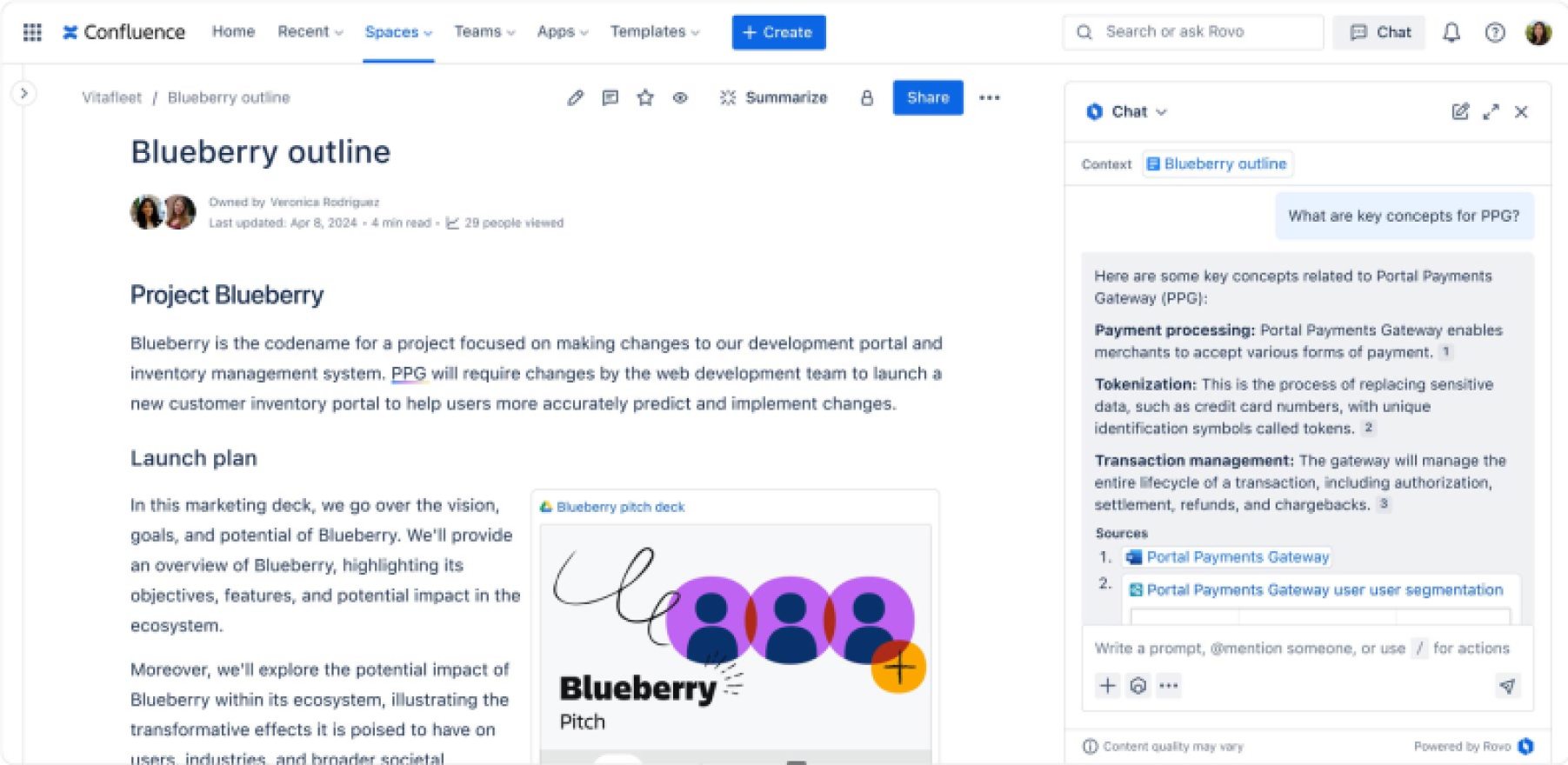
This isn’t limited to the Rovo experience within Atlassian but also off-platform. The company plans to release a browser extension, bringing this functionality to third-party apps like Google Docs. Think Grammarly meets Webster, but for the workplace. “Your company’s knowledge will follow you where you go to make it easier to learn,” Mansour remarks.
Act
The final piece of this is called Rovo Agents, which are specialized bots organizations can use in workflows to tackle time-consuming tasks, help complete projects, and more. These AI agents are tasked to help employees newly equipped with knowledge take action.
“This is the most exciting part of Rovo for me,” Mansour proclaims. “I think it’s really speaking towards our mission of unleashing the potential of every team. And we believe every team in the future will be working with these virtual teammates…and these agents will be controlled and owned by the teams—administered by your company’s administrator—and teams can create these agents to help them work faster and smarter and give them more time of the day to work on more exciting things.”
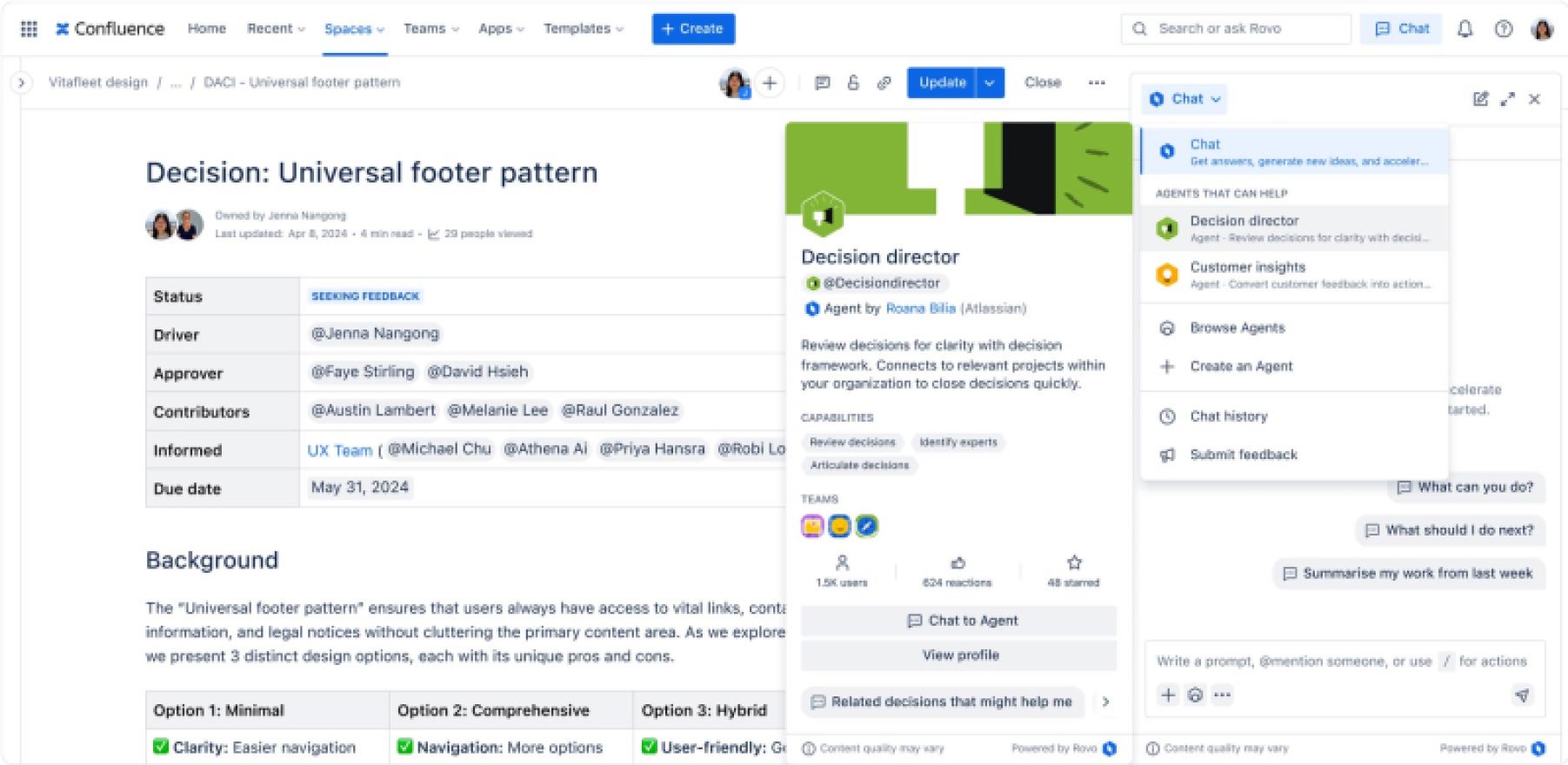
One of the first AI agents Atlassian is making available is Backlog Buddy. It helps teams clean up their work backlog, reducing the amount of manual human work hours spent completing this task. In his demonstration, Mansour activated Backlog Buddy through Rovo Chat. Workers can ask this bot to scan a document and extrapolate tasks to create a backlog, something that would normally require human workers to manually copy and paste tasks to group them.
He emphasizes that humans will always be in control of AI agents. These bots “never do anything automatically.” Instead, they suggest things, and humans can review, modify or accept the changes.
Here are some of the things agents are capable of doing:
- Generate, review and refine content for marketing and communications, product specifications, goal descriptions and more
- Automate and streamline tasks for new design requests, taking action when a Jira ticket progresses or reviewing content
- Answer questions, recommend best practices, integrate research into Jira specifications, create service checklists or contribute to custom knowledge bases
- Assist with onboarding new employees and facilitating team collaboration
- Streamlining time-consuming tasks like cleaning up Jira backlogs, organizing Confluence pages and more
In addition to off-the-shelf agents, Rovo supports bespoke agents, which can be created using Atlassian’s no-code text interface. Mansour also reveals that Atlassian will open up its agent platform to all developers building apps for the platform. He shares that at least 15 companies are building agents or tools for the platform.
When will Rovo be available?
Though announced today, Atlassian Rovo is only currently available to a select group of customers. You can sign up for the waitlist and be notified when access is granted.
However, according to Atlassian’s admission, not every component has been fully developed. “Rovo Search, Rovo Learn and Rovo [Agents] are all early access…at different stages…Find and learn are well ahead. Agents just started, so that’s still early days with that one,” Mansour discloses. He estimates Rovo could open before the end of the year.
Rovo is available on the web. Though no dedicated mobile app exists, Rovo Search can be accessed via the mobile web. Some Rovo Learn features will contextually appear on Confluence’s mobile app, with Jira support added later.
Finally, Rovo can be purchased as part of Atlassian’s app cloud editions. The company anticipates having “pretty flexible pricing” based on the number of seats, but detailed pricing information won’t be available until closer to Rovo’s general release.

